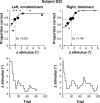Age-based model for metacarpophalangeal joint proprioception in elderly
- PMID: 28435235
- PMCID: PMC5388205
- DOI: 10.2147/CIA.S129601
Age-based model for metacarpophalangeal joint proprioception in elderly
Abstract
Neurological injuries such as stroke can lead to proprioceptive impairment. For an informed diagnosis, prognosis, and treatment planning, it is essential to be able to distinguish between healthy performance and deficits following the neurological injury. Since there is some evidence that proprioception declines with age and stroke occurs predominantly in the elderly population, it is important to create a healthy reference model in this specific age group. However, most studies investigate age effects by comparing young and elderly subjects and do not provide a model within a target age range. Moreover, despite the functional relevance of the hand in activities of daily living, age-based models of distal proprioception are scarce. Here, we present a proprioception model based on the assessment of the metacarpophalangeal joint angle difference threshold in 30 healthy elderly subjects, aged 55-80 years (median: 63, interquartile range: 58-66), using a robotic tool to apply passive flexion-extension movements to the index finger. A two-alternative forced-choice paradigm combined with an adaptive algorithm to define stimulus magnitude was used. The mixed-effects model analysis revealed that aging has a significant, increasing effect on the difference threshold at the metacarpophalangeal joint, whereas other predictors (eg, tested hand or sex) did not show a significant effect. The adaptive algorithm allowed reaching an average assessment duration <15 minutes, making its clinical applicability realistic. This study provides further evidence for an age-related decline in proprioception at the level of the hand. The established age-based model of proprioception in elderly may serve as a reference model for the proprioceptive performance of stroke patients, or of any other patient group with central or peripheral proprioceptive impairments. Furthermore, it demonstrates the potential of such automated robotic tools as a rapid and quantitative assessment to be used in research and clinical settings.
Keywords: MCP; aging; difference threshold; hand function; joint position sense; presbypropria; robotic assessment; somatosensation.
Conflict of interest statement
Disclosure The authors report no conflicts of interest in this work.
Figures



Similar articles
-
Reliability, validity, and clinical feasibility of a rapid and objective assessment of post-stroke deficits in hand proprioception.J Neuroeng Rehabil. 2018 Jun 7;15(1):47. doi: 10.1186/s12984-018-0387-6. J Neuroeng Rehabil. 2018. PMID: 29880003 Free PMC article. Clinical Trial.
-
Proprioceptive assessment in clinical settings: Evaluation of joint position sense in upper limb post-stroke using a robotic manipulator.PLoS One. 2017 Nov 21;12(11):e0183257. doi: 10.1371/journal.pone.0183257. eCollection 2017. PLoS One. 2017. PMID: 29161264 Free PMC article.
-
A Tablet-Based Tool for Accurate Measurement of Hand Proprioception After Stroke.J Neurol Phys Ther. 2019 Apr;43(2):106-116. doi: 10.1097/NPT.0000000000000259. J Neurol Phys Ther. 2019. PMID: 30883498
-
Proprioceptive sensibility in the elderly: degeneration, functional consequences and plastic-adaptive processes.Neurosci Biobehav Rev. 2009 Mar;33(3):271-8. doi: 10.1016/j.neubiorev.2008.08.012. Epub 2008 Aug 26. Neurosci Biobehav Rev. 2009. PMID: 18793668 Review.
-
Upper extremity proprioception in healthy aging and stroke populations, and the effects of therapist- and robot-based rehabilitation therapies on proprioceptive function.Front Hum Neurosci. 2015 Mar 2;9:120. doi: 10.3389/fnhum.2015.00120. eCollection 2015. Front Hum Neurosci. 2015. PMID: 25784872 Free PMC article. Review.
Cited by
-
Aging increases proprioceptive error for a broad range of movement speed and distance estimates in the upper limb.Front Hum Neurosci. 2023 Oct 11;17:1217105. doi: 10.3389/fnhum.2023.1217105. eCollection 2023. Front Hum Neurosci. 2023. PMID: 37886690 Free PMC article.
-
A data-driven framework for selecting and validating digital health metrics: use-case in neurological sensorimotor impairments.NPJ Digit Med. 2020 May 29;3:80. doi: 10.1038/s41746-020-0286-7. eCollection 2020. NPJ Digit Med. 2020. PMID: 32529042 Free PMC article.
-
The Evolution of Hand Proprioceptive and Motor Impairments in the Sub-Acute Phase After Stroke.Neurorehabil Neural Repair. 2023 Dec;37(11-12):823-836. doi: 10.1177/15459683231207355. Epub 2023 Nov 13. Neurorehabil Neural Repair. 2023. PMID: 37953595 Free PMC article.
-
Quantification of upper limb position sense using an exoskeleton and a virtual reality display.J Neuroeng Rehabil. 2018 Mar 16;15(1):24. doi: 10.1186/s12984-018-0367-x. J Neuroeng Rehabil. 2018. PMID: 29548326 Free PMC article.
-
Age-Dependent Asymmetry of Wrist Position Sense Is Not Influenced by Stochastic Tactile Stimulation.Front Hum Neurosci. 2020 Mar 3;14:65. doi: 10.3389/fnhum.2020.00065. eCollection 2020. Front Hum Neurosci. 2020. PMID: 32194386 Free PMC article.
References
-
- Gardner E, Martin J. The bodily senses. In: Kandel ER, JT, editors. Principles of Neural Science. New York: McGraw-Hill; 2000. pp. 430–450.
-
- McPhee SD. Functional hand evaluations: a review. Am J Occup Ther. 1987;41(3):158–163. - PubMed
-
- Overvliet KE, Smeets JB, Brenner E. The use of proprioception and tactile information in haptic search. Acta Psychol (Amst) 2008;129(1):83–90. - PubMed
MeSH terms
LinkOut - more resources
Full Text Sources
Other Literature Sources
Medical
Miscellaneous

